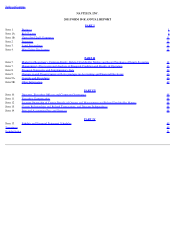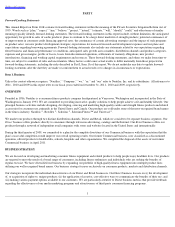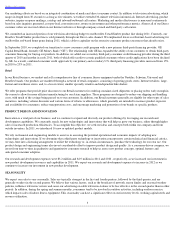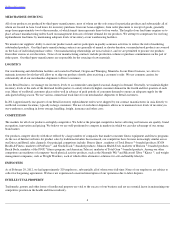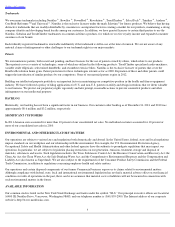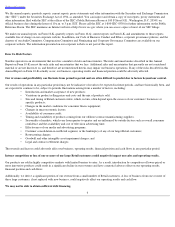Nautilus 2011 Annual Report Download - page 14
Download and view the complete annual report
Please find page 14 of the 2011 Nautilus annual report below. You can navigate through the pages in the report by either clicking on the pages listed below, or by using the keyword search tool below to find specific information within the annual report.
Table of Contents
We had goodwill of $2.9 million and other intangible assets of $16.7 million as of December 31, 2011. Any future impairment charges, if
significant, could materially and adversely affect our operating results. An unexpected decline in revenue, changes in market conditions, changes
in competitive products or technologies or a change in management's intentions regarding utilization of intangible assets could lead to further
impairment charges.
We are subject to periodic litigation, product liability risk and other regulatory proceedings which could result in unexpected expense of
time and resources.
From time to time, we may be a defendant in lawsuits and regulatory actions relating to our business or the former operations of our discontinued
Commercial business segment. Due to the inherent uncertainties of litigation and regulatory proceedings, we cannot accurately predict the
ultimate outcome of any such proceedings. An unfavorable outcome could have a material adverse impact on our business, financial condition
and results of operations. In addition, any significant litigation in the future, regardless of its merits, could divert management's attention from
our operations and may result in substantial legal costs.
We are subject to warranty claims for our products which could result in unexpected expense.
Many of our products carry limited warranties for defects in quality and workmanship. We may experience significant expense as the result of
product quality issues, product recalls or product liability claims which may have a material adverse effect on our business. We maintain a
warranty reserve for estimated future warranty claims. However, the actual costs of servicing future warranty claims may exceed the reserve and
have a material adverse effect on our results of operations, financial condition and cash flows. In addition, we remain contingently liable for
product warranty obligations which were transferred to buyers of our Commercial business product lines, if the buyer is unable to fulfill such
obligations.
Disruption to our information and communication systems could result in interruptions to our business.
Our business is reliant on information and communication technology, and a substantial portion of our revenues are generated with the support
of information and communication systems. The success of our Direct business is heavily dependent on our ability to respond to customer sales
inquiries and process sales transactions using our call center communication systems, Internet websites and similar data monitoring and
communication systems provided and supported by third-parties. If such systems were to fail, or experience significant or lengthy interruptions
in availability or service, our revenues could be materially affected. We also rely on information systems in all stages of our product cycle, from
design to distribution, and we use such systems as a method of communication between employees, suppliers and customers. In addition, we use
information systems to maintain our accounting records, assist in trade receivables collection and customer service efforts, and forecast operating
results and cash flows.
System failures or service interruptions may occur as the result of a number of factors, including: computer viruses; hacking or other unlawful
activities by third parties; disasters; equipment, hardware or software failures; cable outages, extended power failures, or our inability or failure
to properly protect, repair or maintain our communication and information systems. To mitigate the risk of business interruption, we have in
place a disaster recovery program that targets our most critical operational systems. If our disaster recovery system is ineffective, in whole or in
part, or efforts conducted by us or third-parties to prevent or respond to system interruptions in a timely manner are ineffective, our ability to
conduct operations would be significantly affected. If we do not consider the potential impact of critical decisions related to systems or process
design and implementation, this could lead to operational challenges and increase costs. Any of the aforementioned factors could have a material
adverse affect on our operating results, financial position and cash flows.
If we are unable to maintain compliance with the continued listing standards of the New York Stock Exchange, we may become subject
to delisting proceedings.
Our common stock currently is traded on the New York Stock Exchange (the “NYSE”). The NYSE's continued listing standards require that
listed companies maintain either an average global market capitalization of not less than $50 million over a consecutive 30 trading-
day period, or
total stockholders' equity of not less than $50 million. On September 23, 2010, we were notified by the NYSE that we were not in compliance
with this requirement for continued listing. On December 3, 2010, we were notified that the NYSE had accepted our plan demonstrating our
ability to regain compliance with the continued listing standards within an 18-month period that ends on March 23, 2012. As of February 29,
2012, our market capitalization over the preceding 30 trading-day period was approximately $75 million, which exceeds the NYSE requirement
for continued listing.
If we are unable to maintain compliance with the NYSE continued listing standards, our common stock could be delisted by the NYSE. Delisting
could negatively impact us by, among other factors, reducing the volume of trading in our common stock and the number of investors willing or
able to hold or acquire our common stock, damaging our reputation and standing with
10


